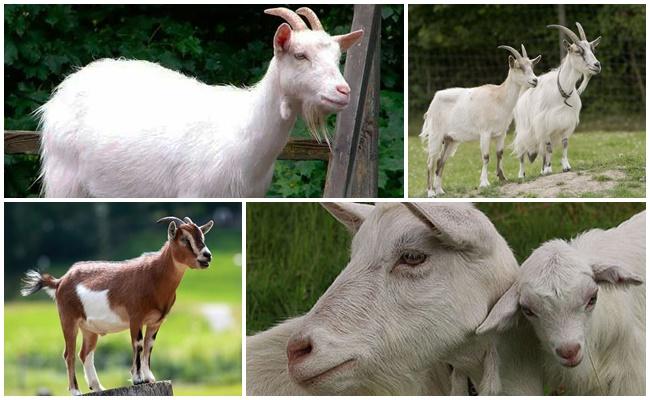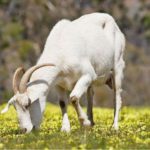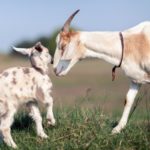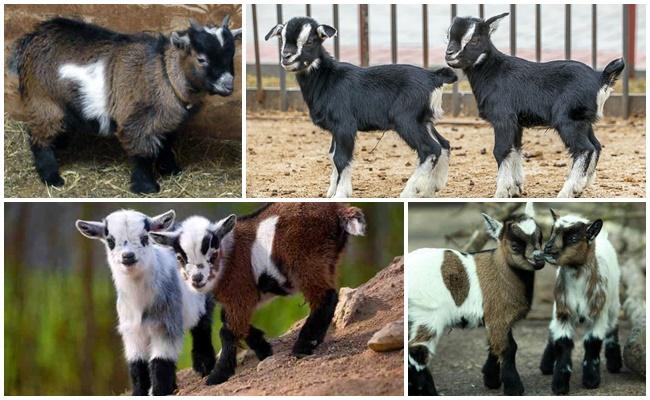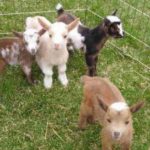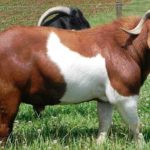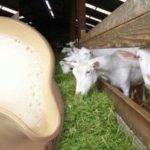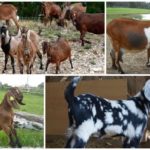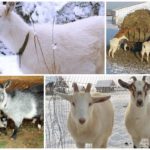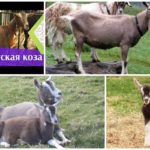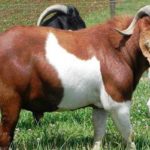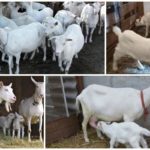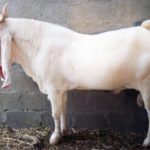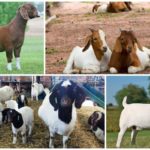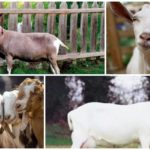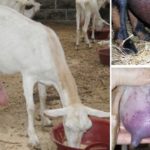When purchasing a pet, you need to know what a healthy goat looks like. After all, there is no point in buying a sick or old specimen. Goats are bred for milk, meat or wool (fluff). Animal productivity depends on age, health and feed. Goats live up to 15 years. True, the peak of their productivity occurs at 5 years of age. Old animals are usually sent to slaughter or tried to be sold on the market.
General description of the animal
A goat is a domestic animal from the class mammals and the genus mountain goats.Its ancestor is considered to be the bezoar goat. True, other representatives of this genus also participated in the creation of various breeds (Alpine, Marked).
In ancient times, these animals lived in southern and western Asia, in steppe, desert and forested regions. They were domesticated many thousands of years ago. Currently, they are bred in different parts of the world. All European domestic goats are descended from Asian ancestors. Animals are raised for meat, milk, wool, fluff, and skins.
Domestic goats reach a height (at the withers) of 0.5-1 meters. The length of the body is 0.6-1.2 m plus a tail of 10-20 cm. The weight of the animal, depending on the breed, is 25-130 kilograms. Goats have a narrow-bodied, angular exterior. Legs are straight, strong, with hooves. The body is covered with short or long hair. Color - white, black, brown, red, spotted.
Animals have a beard (both sexes) and horns (longer in males). Only female dairy breeds have outgrowths on their necks - earrings.
Males have a very pungent odor during the breeding period. Goats with dark fur smell stronger than those with white fur. Animals willingly go into mating. Goats reach sexual maturity at 5-8 months. True, they are allowed to mate at 1-1.5 years. Pregnancy in females lasts 5 months. They usually give birth to 1-4 young, which are fed milk for up to 3 months.
After lambing, the goats begin to milk. They give 1-5 liters of milk per day. The udder in females consists of two lobes. It has 2 or 4 nipples. The shape of the udder is pear-shaped or cup-shaped. Females are covered annually to prolong lactation. The productive period is 7-9 years. These animals have excellent health. They are immune to plague and scabies, and rarely suffer from tuberculosis.At 3 months of age, they are vaccinated against anthrax, brucellosis, foot-and-mouth disease, rabies, and parasites.
It is also profitable to raise goats because they eat less than cows. True, their productivity is lower than that of cattle. The diet consists of grass in summer and hay in winter. They are given vegetables, grain mixtures, branches of trees and shrubs as top dressing.
Varieties of goat breeds
Animals are mainly bred for milk, meat, fluff and wool. A huge number of breeds have been bred. Every corner of the world has its own species, most adapted to living in a particular area.
Dairy
In our area, they mainly breed Alpine dairy goats. These include: Saanen, including Russian White or Gorky, as well as Toggenburg, Appenzell, French, British or Italian Alpine. There are other dairy breeds: Megrelian, Spanish, Nubian, Maltese.
All goats of this type produce 2-5 liters of milk per day with 3-6% fat content. Productivity per year is 500-700 kilograms. Record holders give up to 8 liters of milk per day. Such animals weigh about 50-60 kilograms. They are kept only for 7-9 years; at older ages, milk yields drop.
Meat
Meat goats differ from dairy goats in that they quickly gain weight. Kids are born weighing 4 kilograms. They eat, like all ruminant domestic animals, grass and hay. By 10-12 months they weigh more than 100 kilograms. The most common meat breeds are Boer and Kiko. True, in our area they are rarely bred due to the high cost of breeding individuals (1-1.5 thousand dollars).
Wool and down
The most valuable downy breeds are considered to be the Don and Orenburg.Such animals produce about 500 grams of fluff per year, and up to 300 liters of milk. Their color is white, blue, black, brown or gray. In Orenburg goats, the down is shorter than the spine, while in the Don goats, on the contrary, it is longer.
Downy ones include Kyrgyz, Uzbek, Volgograd, and Kashmir. There is also a Gorno-Altai breed with a black spine and solid dark gray down. Representatives of this type also have a light color. Animals are also bred to produce wool, which is used in the knitting and textile industries.
Mixed type
Most often, mixed goats are raised on private farms, from which they obtain milk, meat, wool and skins. These are mestizos, that is, animals obtained from different breeds (wool, down, dairy). They have medium-length fur and a large udder. One animal produces up to 350 liters of milk per year.
Pygmy goats
There are also decorative dwarf goats that look like young goats. They grow to only 0.5 meters in height (at the withers) and produce about 1 liter of milk per day. The most common are Cameroonian, Nigerian, La Mancha and Dwarf Nubian.
The most popular representatives
In Russia, in rural areas, goats of short-haired breeds are mainly raised: Russian, Gorky, Saanen. These are animals with good immunity, they are adapted to the climate of the middle zone, they begin to milk at the age of 2 years, they give 2-4 liters
and milk per day. In Russia, Orenburg and Don long-haired animals are kept for the sake of fluff. Summer residents often have dwarf ornamental goats.Animals belonging to mini breeds can even live in an apartment.
Recently, local farmers have begun to breed eastern long-eared goats (Gulabi, Bitali, Kamori). These animals have an unusual appearance: long drooping ears. Adult goats weigh about 90 kilograms and produce very tasty, sweet and fatty milk.
How to choose the right goat
Animals are bought for milk, meat, wool or fluff. It is better to buy common dairy breeds from a local farmer or ordinary villager. They cost about 50-100 dollars. Breeding individuals are purchased from breeders on special farms. Such animals cost from $300 and above.
For home breeding, they usually buy first kittens or female goats after 2-3 lambings. Young animals are more productive and quickly get used to their new owner. They produce the most milk at 5 years of age. It is advisable not to buy animals over 7 years old. Milk yield decreases with age. When purchasing a dairy breed, pay attention to the udder. It should be elastic, pear-shaped or cup-shaped. The udder should not sag and the nipples should not point outward. An asymmetrical shape indicates the consequences of mastitis or injury.
The ideal udder has a high position and good attachment. The nipples are of medium length, convenient for milking. After milking, the udder should fall off and the skin on it should gather into folds. There should be no compactions in the lobes; their presence indicates mastitis.
A healthy goat has a good appetite, eats voraciously, has a barrel-shaped body and a large udder. Dairy breeds have an angular, cone-shaped body, while meat breeds have a square body. Goats bred for meat eat a lot but produce little milk. All nutrition is spent on the development of muscle mass.Dairy goats have soft and fine wool, while meat goats, on the contrary, have coarse hair.
You can look into the goat's mouth. In sick animals, caries is noticeable on the teeth. The length of the incisors wears down with age. Old goats have loose teeth. Gaps appear between the incisors on the lower jaw. A healthy young goat at 3 years of age should have 32 teeth in her mouth.
Most often, they sell not milking goats, but kids aged 3-5 months. After all, animals are covered every year to prolong lactation and increase milk yield. For up to 3 months, goat kids feed on milk, and then switch to plant foods.
When purchasing small animals, it is advisable to meet their mother to understand how much milk they will produce. True, such goats will begin to milk only after the first lambing, that is, somewhere in the second year of life. But the health and future productivity of the kids completely depend on the new owner (on the diet and living conditions).
When purchasing down and wool goats, first of all, pay attention to the condition of the down and wool. Such animals are purchased before grooming and grooming begin. For example, when buying Orenburg goats, they look at the thickness of their wool. The fluff must be at least 5 centimeters in length. The best representatives of this breed have hair all over their bodies. The legs of Orenburg goats should be straight, the hooves should be large and shiny, and the body should be barrel-shaped. When choosing an animal of any breed, criteria such as age, dental condition and udder shape are taken into account.

